Gallery of Carbon's Travels
Disclaimer: This material is being kept online for historical purposes. Though accurate at the time of publication, it is no longer being updated. The page may contain broken links or outdated information, and parts may not function in current web browsers.
Gallery of Carbon's Travels
-
 Riding a bike adds no greenhouse gases to the atmosphere.
Riding a bike adds no greenhouse gases to the atmosphere. -
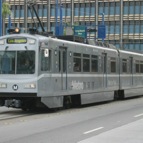 The Los Angeles Metro helps people travel without cars, cutting back on harmful greenhouse gas emissions.
Photo credit: Metro Transportation Library and Archive.
The Los Angeles Metro helps people travel without cars, cutting back on harmful greenhouse gas emissions.
Photo credit: Metro Transportation Library and Archive. -
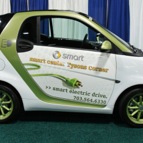 This electric “Smart Car” runs without releasing heat-trapping greenhouse gases.
Photo credit: mariodo59.
This electric “Smart Car” runs without releasing heat-trapping greenhouse gases.
Photo credit: mariodo59.
-
 Commuters ride to work on a city bike path, adding no greenhouse gases to the atmosphere.
Photograph by Greg Stephens.
Commuters ride to work on a city bike path, adding no greenhouse gases to the atmosphere.
Photograph by Greg Stephens. -
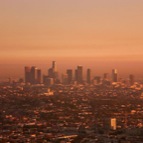 Pollution from cars and factories can create dense smog in cities.
Photo credit: Metro Transportation Library and Archive
Pollution from cars and factories can create dense smog in cities.
Photo credit: Metro Transportation Library and Archive
-
 A car’s emissions are checked at a station in California.
Photograph by R. Couse-Baker
A car’s emissions are checked at a station in California.
Photograph by R. Couse-Baker
-
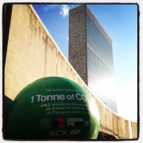 Burning 110 gallons of gasoline will produce one metric ton of carbon dioxide, enough to fill this green balloon in front of the United Nations building.
Burning 110 gallons of gasoline will produce one metric ton of carbon dioxide, enough to fill this green balloon in front of the United Nations building.
-
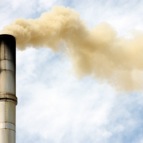 A smokestack releases greenhouse gases and other pollutants into the atmosphere.
A smokestack releases greenhouse gases and other pollutants into the atmosphere.
-
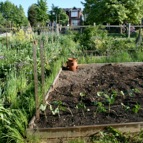 Gardens help reduce global warming because plants remove carbon dioxide from the atmosphere. Photograph by Bet Taylor.
Gardens help reduce global warming because plants remove carbon dioxide from the atmosphere. Photograph by Bet Taylor.
-
 Planting vegetables not only produces tasty food, but it also helps to remove carbon dioxide from the atmosphere.
Planting vegetables not only produces tasty food, but it also helps to remove carbon dioxide from the atmosphere.
-
 Planting a garden is a great way to remove carbon from the atmosphere.
Planting a garden is a great way to remove carbon from the atmosphere.
-
 These baby pine trees will help regrow areas where forests have been cut down and help to remove carbon from the atmosphere.
These baby pine trees will help regrow areas where forests have been cut down and help to remove carbon from the atmosphere.
-
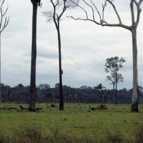 This field in Brazil used to be a thick rainforest. Rainforests are important because they help remove carbon dioxide from the atmosphere.
Photo credit: UN Photo/P Sudhakaran
This field in Brazil used to be a thick rainforest. Rainforests are important because they help remove carbon dioxide from the atmosphere.
Photo credit: UN Photo/P Sudhakaran
-
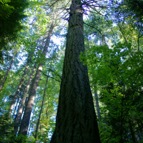 This old-growth Douglas Fir tree keeps a lot of carbon out of the atmosphere.
Photo credit: US Fish and Wildlife Service
This old-growth Douglas Fir tree keeps a lot of carbon out of the atmosphere.
Photo credit: US Fish and Wildlife Service
-
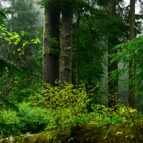 A thick forest on the Oregon coast. Forests help cool the planet by removing carbon dioxide from the atmosphere. Photo credit: US Fish and Wildlife Service.
A thick forest on the Oregon coast. Forests help cool the planet by removing carbon dioxide from the atmosphere. Photo credit: US Fish and Wildlife Service. -
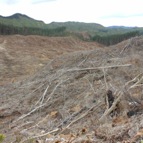 This heavily deforested area no longer helps keep carbon out of the atmosphere.
This heavily deforested area no longer helps keep carbon out of the atmosphere. -
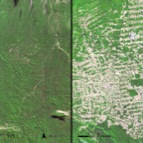 A section of Brazilian rainforest from 1975 (left) and 2009 (right). The white portions have been stripped of trees.
Photo credit: United Nations Environment Programme (UNEP). From Latin America and the Caribbean Atlas of our Changing Environment (2010).
A section of Brazilian rainforest from 1975 (left) and 2009 (right). The white portions have been stripped of trees.
Photo credit: United Nations Environment Programme (UNEP). From Latin America and the Caribbean Atlas of our Changing Environment (2010).
-
 A bird sits in a nest surrounded by trash that could have been recycled.
A bird sits in a nest surrounded by trash that could have been recycled.
-
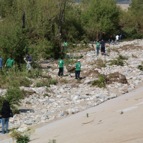 Volunteers remove trash that has washed up on a beach.
Volunteers remove trash that has washed up on a beach.
-
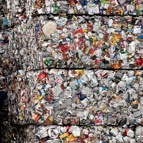 Recycling these stacks of aluminum cans will save a lot of energy.
Photograph by Laura Gilmore.
Recycling these stacks of aluminum cans will save a lot of energy.
Photograph by Laura Gilmore.
-
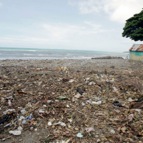 Trash litters a beach in Haiti.
Photo credit: UN Photo/Sophia Paris.
Trash litters a beach in Haiti.
Photo credit: UN Photo/Sophia Paris.
-
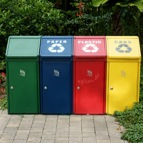 Recycling paper, plastic, and aluminum helps reduce energy costs and greenhouse gas emissions.
Recycling paper, plastic, and aluminum helps reduce energy costs and greenhouse gas emissions. -
 Birds scavenge for food above a landfill.
Photo credit: UN Photo/Evan Schneider
Birds scavenge for food above a landfill.
Photo credit: UN Photo/Evan Schneider
-
 Recycling these plastic bottles will save a lot of energy.
Recycling these plastic bottles will save a lot of energy.
-
 A massive dump in Dhaka, Bangladesh.
Much of the large amount of waste humans produce ends up in dumps.
Photo credit: UN Photo/Kibae Park
A massive dump in Dhaka, Bangladesh.
Much of the large amount of waste humans produce ends up in dumps.
Photo credit: UN Photo/Kibae Park
-
 Humans produce a huge amount of waste – much of it ends up in dumps or as litter. Here, trash litters a beach in Timor-Leste.
Photo credit: UN Photo/Martine Perret.
Humans produce a huge amount of waste – much of it ends up in dumps or as litter. Here, trash litters a beach in Timor-Leste.
Photo credit: UN Photo/Martine Perret.
-
 Thrift stores provide a good way to recycle and reuse.
Photograph by Albert Ray Mock.
Thrift stores provide a good way to recycle and reuse.
Photograph by Albert Ray Mock.
-
 Plastic and aluminum cans are sorted for recycling. Recycling saves energy and reduces carbon emissions.
Plastic and aluminum cans are sorted for recycling. Recycling saves energy and reduces carbon emissions.












